NZDFI and ground durable eucalypts
Julian Bateson, New Zealand Tree Grower August 2015.
On the following pages is a report of the ground durable eucalypt field day in June held in the Wairarapa. It also seemed to be a good idea to remind everyone how the ground durable eucalypt project began, and how the NZ Dryland Forests Initiative was formed.
I first heard about ground durable eucalypts when I had a telephone call from Paul Millen about 10 years ago. He asked if I wanted to visit his property and talk about the problem of treated timber posts and the wine industry in Marlborough and a possible hardwood solution. I needed very little convincing and shortly afterwards made the trip to see his newly planted eucalypts and discuss the problem of chemicals leaching from treated timber.
Paul explained how in May 2003 he had been asked to supply naturally durable timber posts to vineyards whose owners did not want to keep using treated timber. He managed to get some locally grown durable eucalypt sawn and sold as posts but with no large forest resource, he decided this was a new opportunity.
Paul and his brother Ash then established Vineyard Timbers Ltd and tested many species of ground durable eucalypts in Marlborough with seed supplied by Proseed NZ Ltd. They then collaborated with the University of Canterbury and Marlborough Research Centre to start a new tree breeding programme based on seed collected from over 300 families of Eucalyptus bosistoana and E. globoidea. These two species are the required class one or two durable timbers which will survive at least 25 years in the ground as untreated posts.
Treated radiata pine
New Zealand depends on timber production almost exclusively from radiata pine. Apart from the obvious risks of relying on a single species, radiata pine has a significant drawback. If it is to be used anywhere damp or wet it has to be treated with chemicals. Currently the treatment of choice is copper-chrome-arsenic usually referred to as CCA. The problem is that the chemicals do not stay in the timber but gradually leach out, and arsenic in particular is a known carcinogen.
How much they leach is a difficult question to answer but other countries have already banned the use of such treatment, particularly if the wood is likely to come into contact with bare human skin, such as on decking. Bans are also in place where treated posts are used and food is grown. New Zealand has no such controls. Many overseas buyers of food and wine produced here are keen to see us stop using treated timber.
The other problem for vineyard posts is that many are broken each year by grape picking machines. The estimate is that as many as 300,000 posts a year have to be replaced in Marlborough. The high cost of landfill disposal is the only safe option to ensure that the broken posts will not pollute the ground water.
The naturally ground durable eucalypt programme aims to solve this problem and supply alternatives to treated pine. Any eucalypt posts which may get broken are not a hazard for disposal and being less brittle, they should not break as often as radiata pine.
How it has all been paid for
In 2008 the NZ Dryland Forests Initiative was established as a tree breeding and forest research project. The aim was to improve drought tolerant eucalypts which produce naturally ground durable hardwood. Agmardt funding in 2008 was followed by the first of two contiguous Sustainable Farming Fund grants obtained in 2010. By early 2015 the total had reached two million dollars, the most recent being the second Sustainable Farming Fund $216,000 grant in 2013.
The latest funding is from the Ministry of Business, Innovation and Employment which in May this year awarded funding of $5 million to a seven year research and development programme. This will mean the work of the Dryland Forests Initiative can now continue, along with work on Douglas fir and cypress.
Where we are now
In 2008 seeds from the first of the open-pollinated seedlots were collected from individual trees growing across the natural range of E. bosistoana in Australia. The containerised seedlings were planted in a range of plots around the country. There are now 30 trial sites throughout eastern New Zealand from North Canterbury to Gisborne with over 140,000 trees planted since 2009. There are 26 land owners and some host more than one type of trial giving a total of individual trials at more than 40. Vineyard Timbers Ltd, Proseed NZ, the School of Forestry and Marlborough Research Centre Trust along with dozens of volunteer growers are hosting trial sites.
Field day for ground durable eucalypts
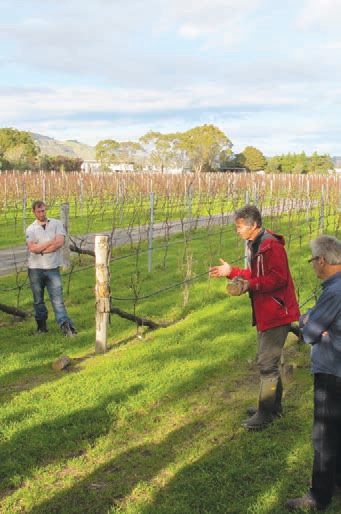
In early June a field day in the Wairarapa was organised by the NZ Drylands Forest Initiative. Two trial sites were visited, one where naturally eucalypt posts were being used in a vineyard and one site where 10,000 ground durable eucalypts had been planted. The day concluded with an evening seminar.
Ata Rangi organic vineyard
We started with a visit to an organic vineyard owned by Clive Paton. Clive said he was a ‘mad’ tree planter interested in eucalypts and as the vineyard became more organic there was a need to stop using treated posts because of the risk of arsenic getting into the water supply.
He had been planting trees including some of the eucalypt species and was looking at alternatives for posts. He remembers how many vineyard posts had to be replaced by vineyard owners in Marlborough where they use more machinery. He said that one owner from Auckland would come down to carry out a bit of work on his vineyard. However he soon realised that he would have to spend all his time replacing treated posts broken by the picking machines. The posts were not strong enough when knocked by the machines because the pine posts become dry and brittle.
Clive realised that there needed to be an alternative such as hardwood posts. The vines could last 150 years if looked after properly and he wanted to look after the long term health of the vineyard for the next 50 or 100 years.
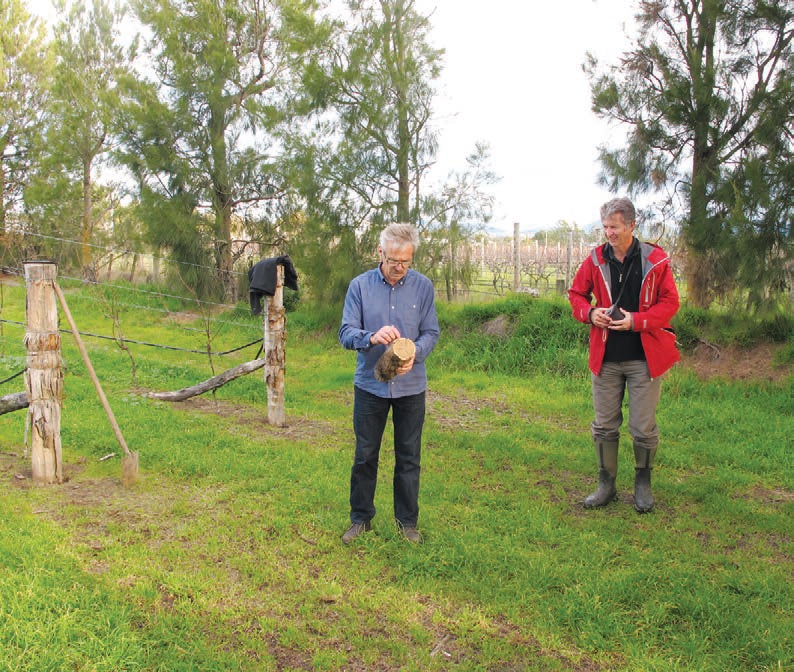
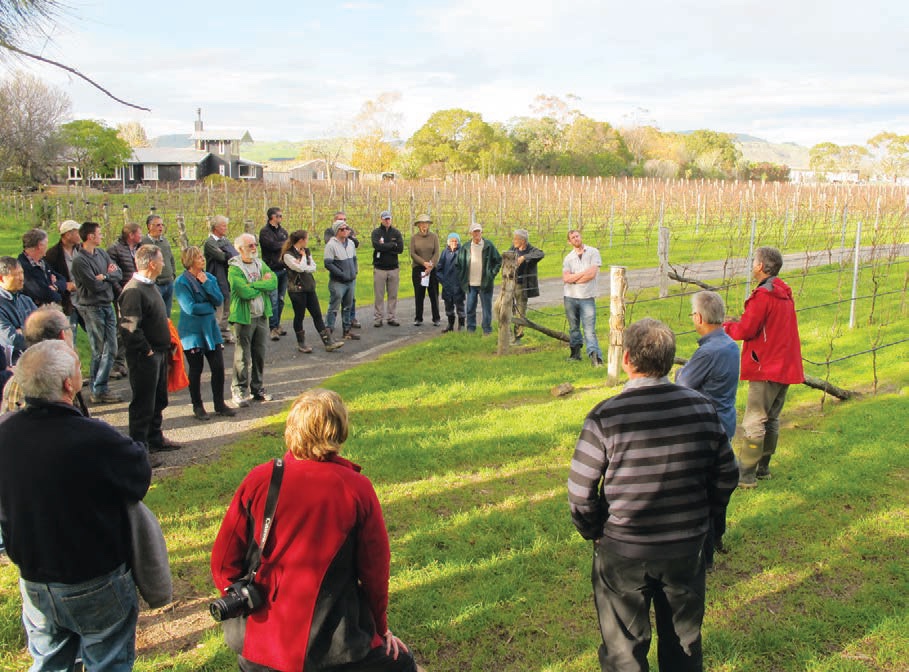
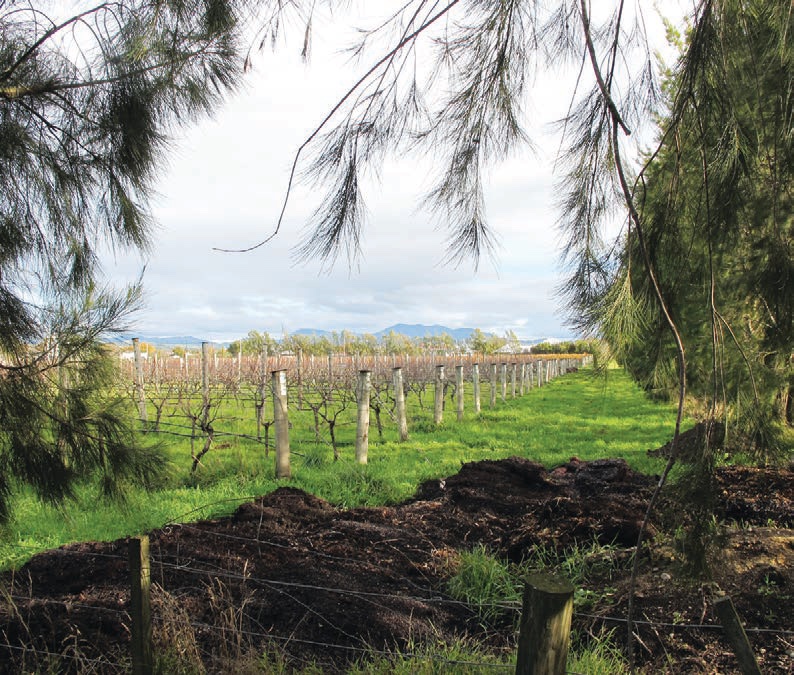
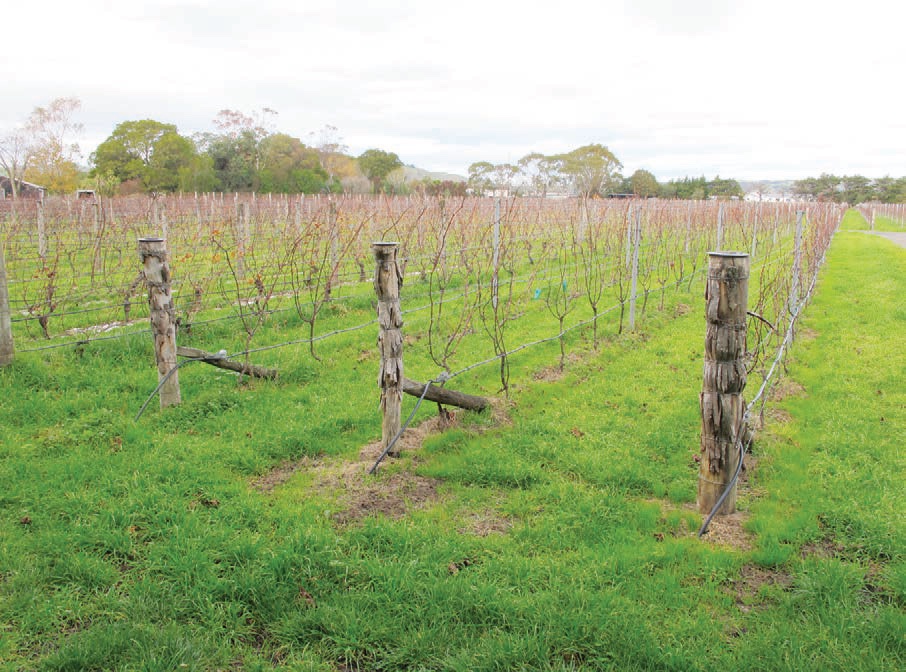
He looked around for woodlots with suitable species and found some 90-year-old Eucalyptus cladocalyx at Holmewood. He managed to get hold of some of the trees which were the perfect post size and he installed them in the vineyard about six years ago as a test. When asked why he left the bark on he said it was because he was told to. It may look a bit scruffy in the early days as the bark gradually falls off but does not cause any problems. So far, only one of the posts had broken, probably because it was a bit smaller than the others and was probably knocked by a tractor.
To show how little decay had occurred over the past six years a spade was produced and the ground around the base of one of the posts was dug out. As the photographs show, the sapwood had decayed but most of the post was still as good as it had been when put in the ground.
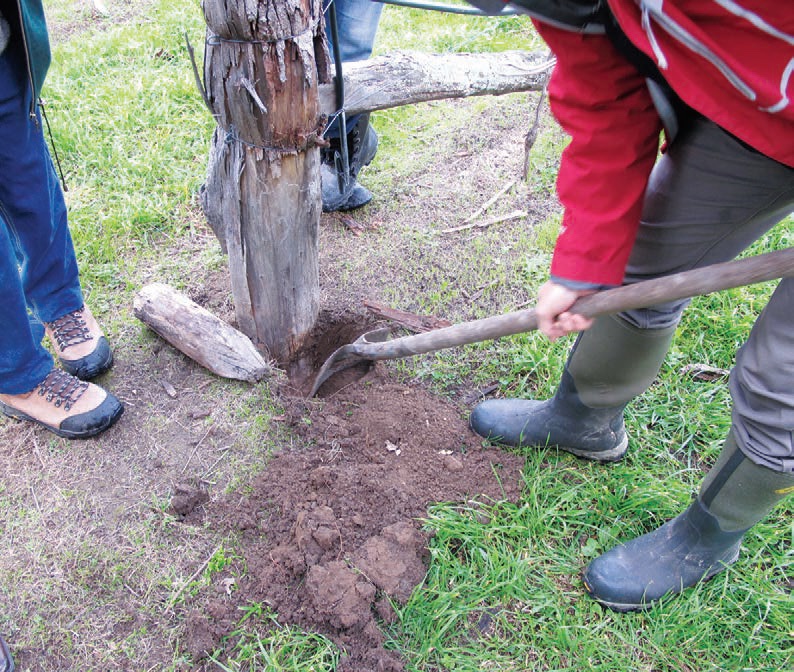
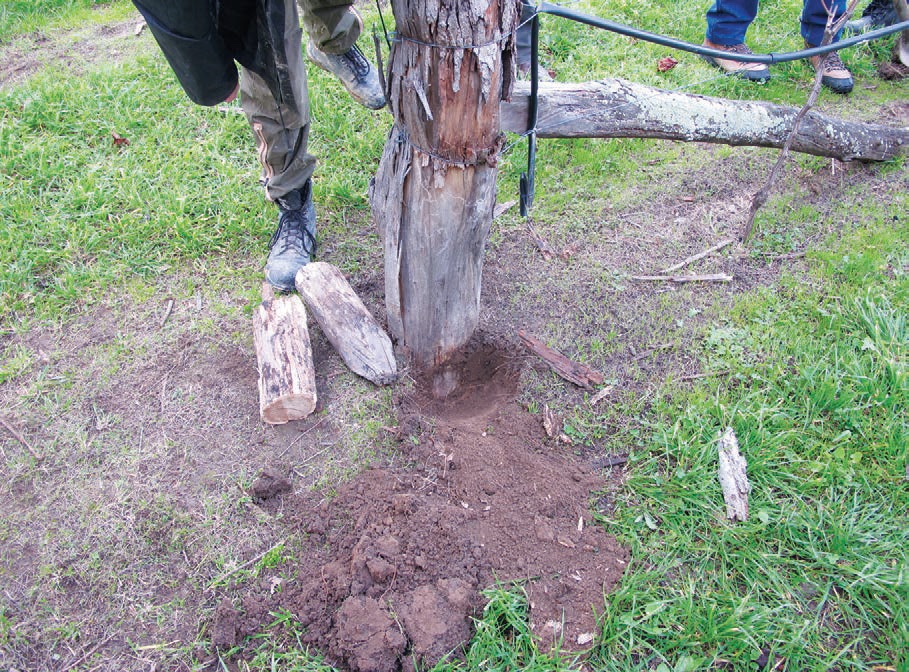
Natural durability
The threat to wood is greatest where the soil is good, damp and with a reasonable temperature. For example in the northern hemisphere it may be damp but it is often very cold or frozen and in Australia it may be warm but very dry with resulting lower threats to wood in the ground. New Zealand has the ideal problem climate and means that wood in the ground decays faster.
The durability of wood in the ground has been outlined previously but Paul explained the details again. Natural durability is an Australian durability standard and if the wood is to be in the ground there are four classes. These are for a stake which is 50 mm square. Larger diameter posts will last significantly longer and for example if it is four times the diameter you should expect it will last up to 50 years
- Class 1 means that the wood will survive for 25 years or more in the ground
- Class 2 means the wood will survive 15 to 25 years in the ground
- Class 3 means the wood will survive 5 to 15 years in the ground
- Class 4 means the wood will survive less than 5 years in the ground.
Many of the chemicals in naturally durable wood are quite toxic and they do eventually leach out from the timber. However, there is a natural degradation path and the chemicals are broken down in the soil whereas chemicals leaching from treated timber are much more persistent and remain in the soil or leach into the ground water.
Untreated radiata pine would be described as class four and a lot of eucalypts are not ground durable even though they are hardwoods. For example E. regnans is class four and E. fastigata is class three. However E. globoidea is class two with some individual trees being class one. The eucalypt breeding programme is looking at these particular trees which involved the second part of the field day.
Pirinoa growing trials for white stringybark (E. globoidea)
The growing trials we looked at were on a certified organic farm. Heather Atkinson had been looking at alternatives to treated posts to avoid the problems of copper-chrome-arsenic leaching from the posts. In the process of her research she met Paul and thought this was a perfect opportunity to discover what might work as a replacement for treated timber posts. Paul explained that at the time of planting the United States was planning to ban the use of copper-chrome-arsenic treated timber in any food growing enterprise so it was another good opportunity to change.
Paul managed to get the best place on the farm to plant the trial plots for growing E. globoidea which is also known as white stringybark. The timber is good for sawing but, as mentioned earlier, the overall average durability is class two, although the timber often performs better than class two in New Zealand conditions. It also grows well on poor sites and seems to be quite resistant to insects which are important benefits. It was noted that if you have to look for insect damage on eucalypts there is probably not much of a problem which seemed to be the case on this site.
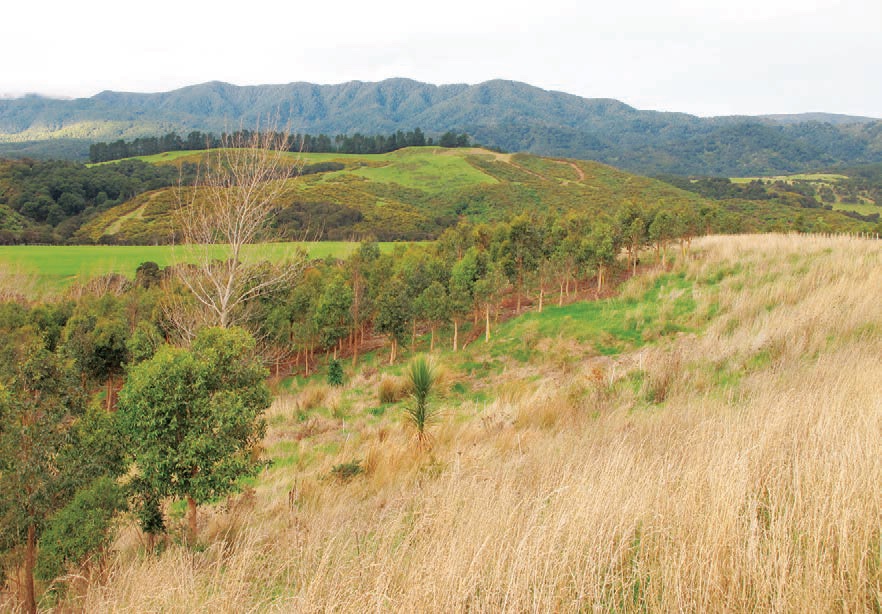
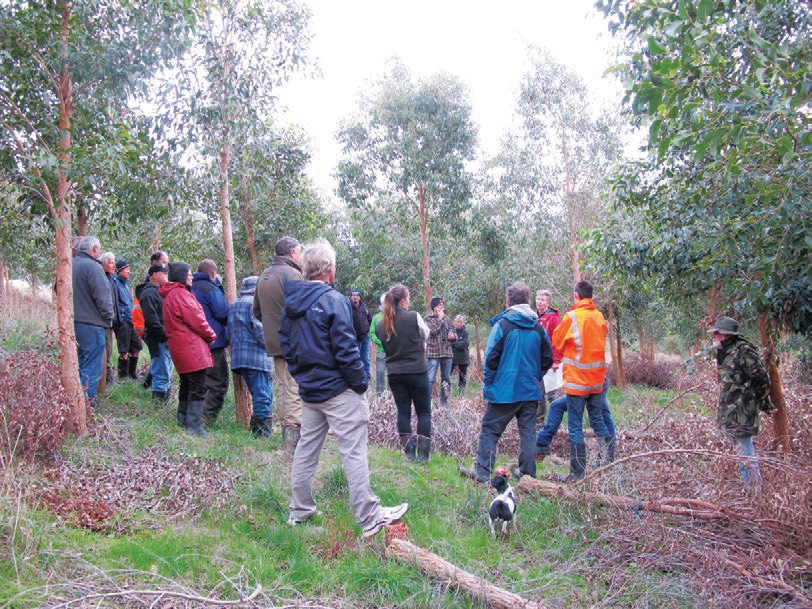
Wide genetic base
The trial needed to have an initial broad genetic base of trees to be able to find the right ones. Therefore seed was collected from around 150 individual mother trees and 75 seedlings were taken from each of these mother trees. This produced over 10,000 trees which were planted just under four years ago. The cost to set up the block, randomly planting the trees with the exact position of each individual known so their performance on different parts of the site can be monitored, has cost between $80,000 and $90,000.
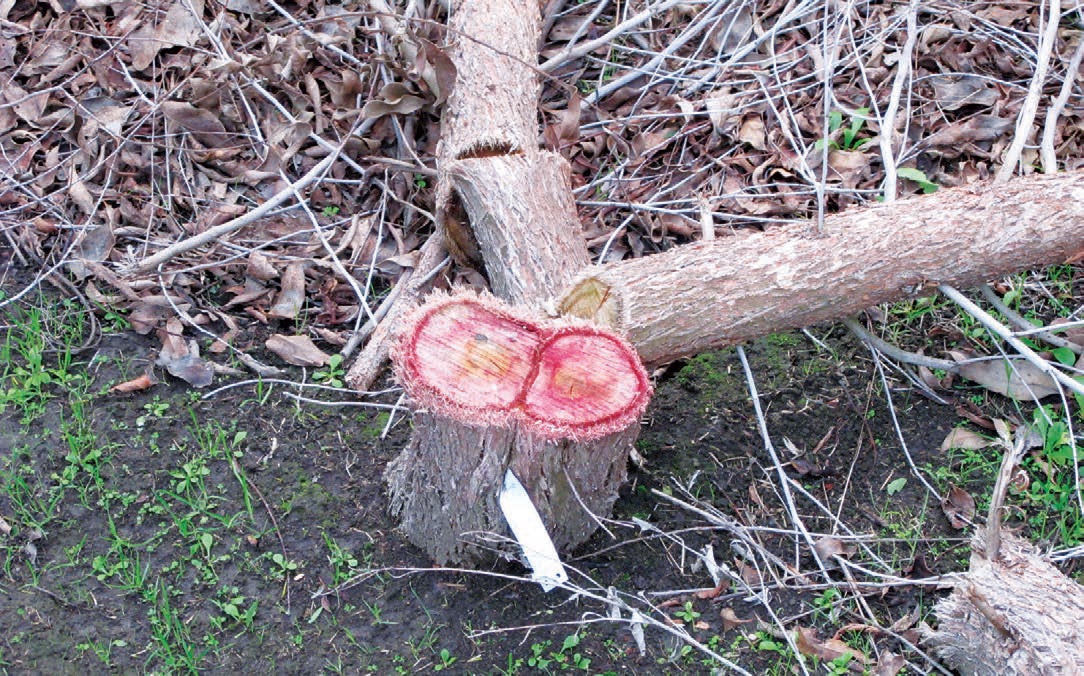
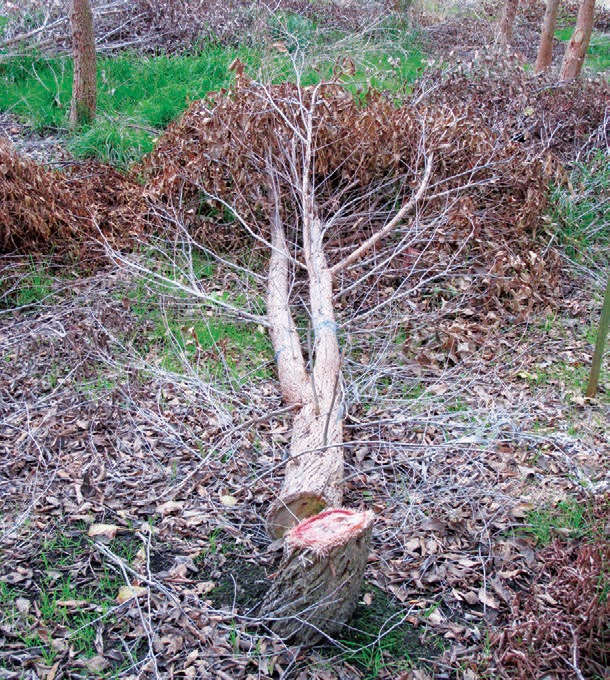
The best of the trees will eventually have cuttings taken and grafted on to roots and put in a seed orchard. To find the best is a process of attrition with all the poor performing trees being gradually removed leaving the good ones to continue growing. Regular measurements are taken in the permanent sample plots. Where the trees are growing at the highest rate, half of them have already been felled − all those with poorer form. Pruning to improve the form of each tree is not being carried out because the aim is to find trees which naturally grow tall and straight without any intervention.
Out of over 10,000 originally planted perhaps only 50 will end up being chosen as good enough to produce straight trees without pruning. The results will be very varied. For example, one mother tree may produce all poor trees, another might produce 50 per cent which are good and another mother tree may be 90 per cent successful. If the third example becomes reality more seeds would be collected from the mother tree rather than cutting and grafting from the current stock.
The stocking rate is quite tight at 2.4 metres by 1.8 metres or about 2,000 per hectare. This is quite intense planting but many are expected to be removed as part of the culling process so no other thinning will be needed. It is expected that the trees could reach 30 metres in height and produce a metre diameter but log with a growth rate equivalent to radiata pine.
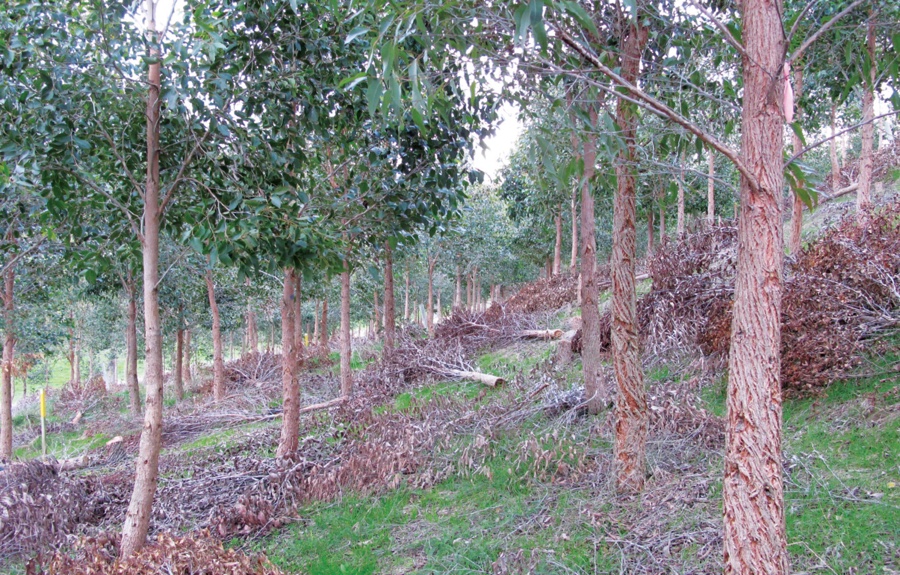
Later in the plot
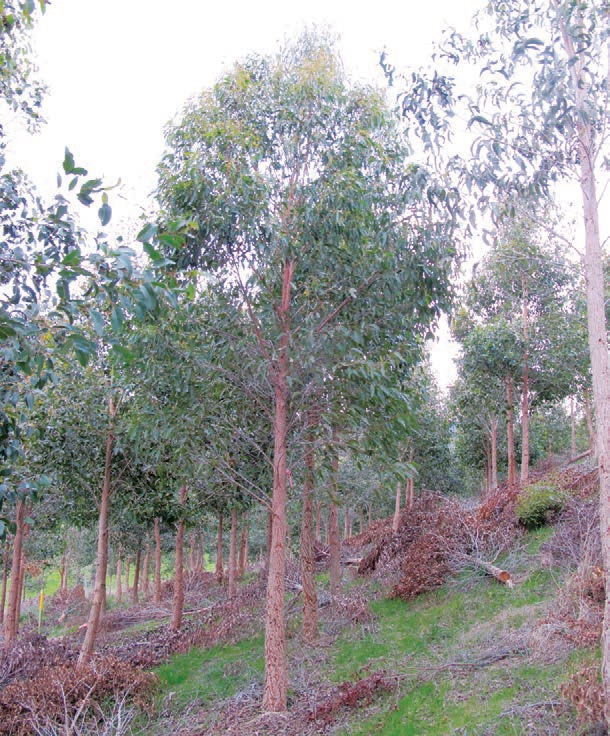
The foliage can be quite varied as there is considerable diversity within the species. Even if it is discovered that some of the trees are not pure E. globoidea it will not be important as they just want the right sort of trees.
Chemicals had been used for weed control around the trees so the block of land which was fully organic was de-certified form its organic status. If no more chemical treatment is used it can be re-certified after three years. Some of the stumps have been poisoned and when they stop poisoning the stumps that will probably be the beginning of the three years.
The weed management could have been kept fully organic but the cost would have been significantly more by using mulches, wool mats or cardboard. Just as important was the need to keep the same standard across all the sites and as the other sites were not organic chemicals were used for pre-plant spray, one release spray treating cut stumps to stop regrowth.
It was a good day to catch up with where this eucalypt project has got to. I am impressed with what has been achieved so far with the work by Paul and the support of everyone involved. Other ground durable eucalypt field days are planned for later on this year. One is in Hawkes Bay in early November and I would recommend that you attend if you have the time.

 Farm Forestry New Zealand
Farm Forestry New Zealand
No posts yet
Add a post